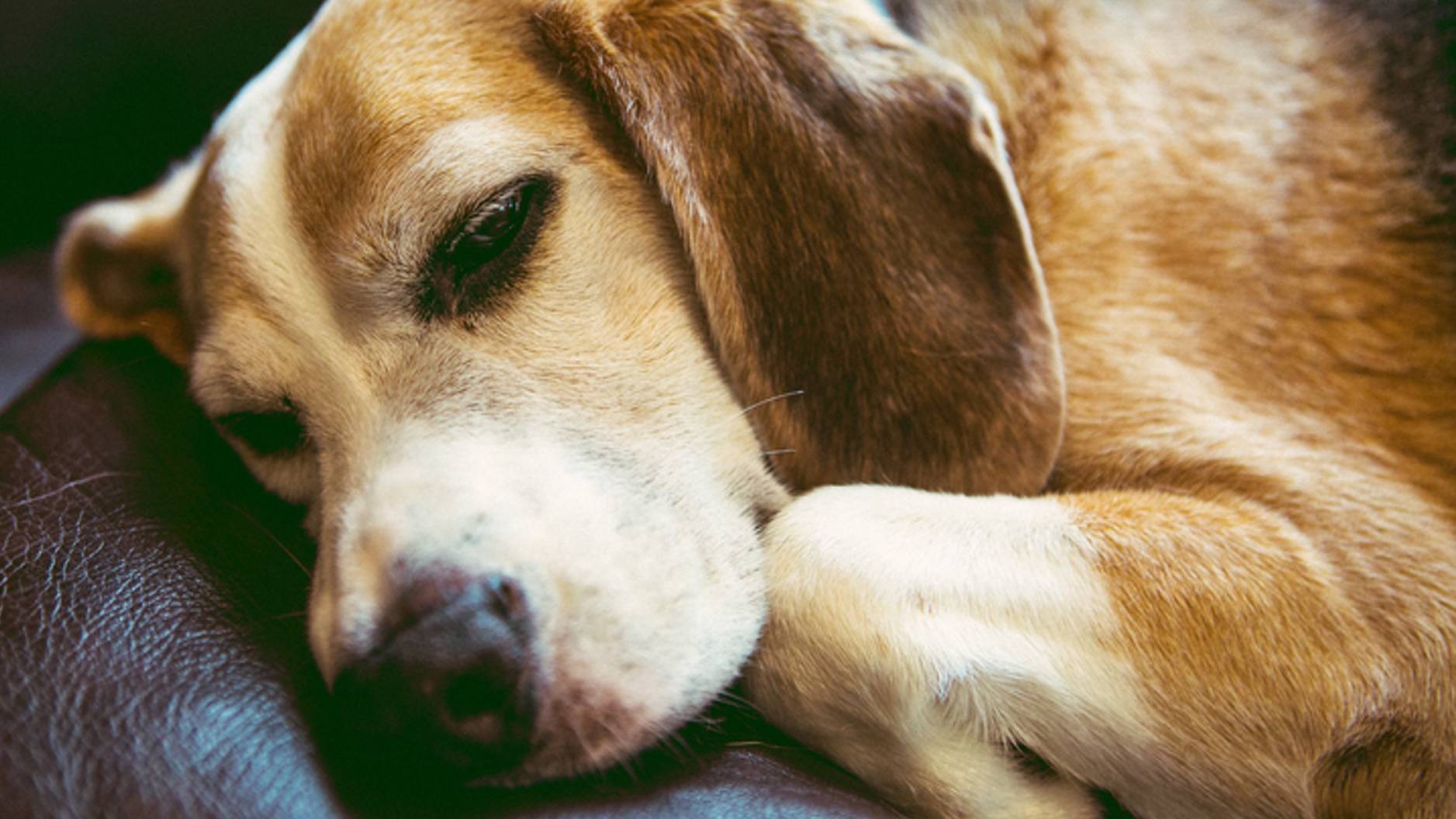Why is my dog twitching in their sleep? Vet's guide to dreaming vs seizures
Is your dog twitching in their sleep? We reveal what’s normal and when to be concerned.

If you’re a pet parent, you might have noticed your dog twitching in their sleep. Firstly, it’s important to note that for the most part, twitching is not uncommon.
Whether they’re in a peaceful slumber dreaming about eating their favorite long-lasting dog chew, playing with one of the best dog toys or they’re keeping themselves occupied in dreamland with one of the best rope dog toys — momentary periods of twitching, vocalization and even paddling are nothing out of the ordinary.
However, while these involuntary muscle spasms are completely normal, they may leave you questioning whether there’s something more serious going on, like a medical or neurological problem. This is why it’s important to know the difference between a really good dream and a warning sign that something is wrong.
To help put your mind at ease, we heard from Dr. Ellen Marcinkiewicz who reveals everything worth knowing about why your dog is twitching in their sleep, the key differences between twitching and a seizure, and the warning signs to look out for — including when it’s time to speak to a vet.

Ellen is a qualified veterinarian with over eight years of experience in small animal practice, working in her home country of Australia and at the Massey University Teaching Hospital in New Zealand. Ellen then moved to the UK, where she worked as a locum vet before making the transition into veterinary communications. Ellen lives with her husband and their borzoi Yeti, and in her free time enjoys travel, yoga, modern calligraphy and dog walks around her home in Somerset
Is it normal for dogs to twitch in their sleep?
Research published in the journal, Behavioral Sciences, has shown that like us, dogs experience stages of dreaming. Stages include rapid eye movement (REM), short-wave sleep (SWS), and non-rapid eye movement (NREM). During REM sleep, the brainstem suppresses the activity of the large muscle groups. This prevents excessive movement when we dream, but small amounts of twitching still take place.
Dogs sleep for 12 to 14 hours a day on average, but the answer to the question 'why do dogs sleep so much' will vary depending on factors like age and activity level. For example, young growing puppies need a lot more sleep than mature adult dogs. Puppies and older dogs are also more likely to experience twitching when they dream, possibly due to development (puppies) or deterioration (senior dogs) of the brainstem and differences in sleep patterns.
Dreaming typically starts after your dog has been asleep for around 20 minutes.
Get the best advice, tips and top tech for your beloved Pets
When your dog is dreaming, they may twitch for brief periods, around 30 seconds at a time. Twitching refers to small, involuntary movements, usually affecting the legs, head, and tail.
You might not expect it, but your dog may also vocalize or cry out — which is known as dog sleep barking — and their legs may kick out or paddle as if they’re running. If that’s the case and you haven’t done so already, learning how to get a dog to sleep in a different room could come in handy.
During REM sleep, your pup’s breathing may also become more shallow than usual.
Why do dogs twitch in their sleep?
Brief periods of twitching are commonly associated with dreaming. However, twitching that is prolonged or accompanied by stiffness or full body convulsions is cause for concern.
Twitching may be caused by abnormal neurological activity, such as seizures. It can also be caused by a number of other medical conditions including:
- Diabetes
- Low blood sugar (hypoglycaemia)
- Low body temperature (hypothermia)
- Toxicity (e.g poisons such as snail bait, medications, or toxic foods such as chocolate)
- Diseases affecting major organs such as the kidneys or liver
- Arthritis
- Anxiety

Is my dog dreaming or having a seizure?
Though twitching during sleep can be normal, it’s important to be able to differentiate between dreaming and abnormal neurological activity, like a seizure.
A seizure, also known as a fit or convulsion, is an involuntary disturbance of normal brain function and typically involves uncontrollable muscle movement. Seizures most commonly occur when a dog is awake, but they may also occur during sleep.
Seizures may be partial (petit mal) where just one part of the body experiences uncontrollable movement (e.g. twitching or tremors). They can also affect the whole body, called a grand mal seizure. A grand mal-type seizure is what most people would recognize as a seizure or fit.
Dogs will usually fall over onto their side with their eyes open. Their whole body will be tremoring, paddling, and moving uncontrollably.
They may also lose control of their bladder and bowels. After a seizure (postictal) your dog may be confused, disorientated, drooling, restless, or experience other changes in behavior.
How to tell if a dog is having a seizure while sleeping
During a seizure, your dog is temporarily unconscious and will not respond to your voice. However, it’s important to be very careful when attempting to wake a dog that may be sleeping, as they can startle and attempt to bite. Instead of touching your dog to rouse them, try gently and calmly calling their name to see if they respond to you.
Why do dogs sleep with their eyes open?
Just like humans, dog sleep positions vary from one fur friend to another. And while most dogs often sleep with their eyes partially closed, they may also sleep with one or both eyes open, especially when dreaming. When your dog’s eyes are partially open, you may also see their third eyelid, called the nictitating membrane, which is a pale pink color.
During REM sleep, your dog’s eyes actually dart around in different directions under their eyelids, which is why this stage of sleep is known as Rapid Eye Movement. You might also notice that your dog sleeps with their eyes open after a recent anesthetic or sedation due to the medications used.
Aging dogs sleep with their eyes open more frequently as well. Although rare, sleeping with open eyes may also be an indication of an underlying health problem. However, your dog would usually be showing other signs of illness, such as seizures or severe weakness.

When to call the vet
If you have any concerns about your dog’s twitching it’s always best to check with a veterinarian. If you can, try to film your dog twitching so you can show your vet, as this may make it easier for them to make a diagnosis.
Signs you should consult a veterinarian include:
- Prolonged episodes of twitching lasting more than 30 seconds
- Loss of consciousness (no response to your voice)
- Twitching, tremors, or uncontrollable body movements when awake
- Loss of control of the bladder or bowels
- Stiffening and full-body tremors or convulsions
- Foaming at the mouth
- Twitching accompanied by vomiting or diarrhea
If you are concerned your dog is having a seizure that lasts longer than 5 minutes (status epilepticus) or they have had multiple seizures in 24 hours, you need to take them to an emergency veterinarian immediately.
Remember, twitching is a normal part of your dog’s sleep and dream cycle, but it’s important to know the difference between twitching and the abnormal neurological activity seen with seizures and other medical conditions. That way, both you and your pup can rest easy!
Struggling to get your canine companion to get the shuteye they need to thrive? Then be sure to check out our vet's guide on how to get a dog to sleep. Or if you’re the one struggling to hit your eight hours and are tired of your canine alarm clock, discover our tips on how to get your dog to sleep later in the morning.
Ellen is an experienced small animal vet and copywriter who graduated from the University of Melbourne in 2012. She has worked in clinics across Australia, the UK and New Zealand, including the Massey University Veterinary Teaching Hospital where she discovered her passion for writing and education. Ellen’s veterinary interests include small animal medicine, surgery, nutrition, and rabbit medicine. She currently lives in Somerset with her fiancé and bouncy borzoi puppy named Yeti.
- Becks ShepherdFreelance Journalist
